Paul-Henri Spaak
Paul-Henri Charles Spaak (25 January 1899 – 31 July 1972) was an influential Belgian Socialist politician, diplomat and statesman. Along with Robert Schuman, Alcide Degasperi and Konrad Adenauer he was a leader in the formation of the institutions that evolved into the European Union.
Paul-Henri Spaak | |
|---|---|
 Spaak, pictured in 1957 | |
| 31st Prime Minister of Belgium | |
| In office 20 March 1947 – 11 August 1949 | |
| Monarch | Charles (as regent) |
| Preceded by | Camille Huysmans |
| Succeeded by | Gaston Eyskens |
| In office 13 March 1946 – 31 March 1946 | |
| Monarch | Charles (as regent) |
| Preceded by | Achille Van Acker |
| Succeeded by | Achille Van Acker |
| In office 15 May 1938 – 22 February 1939 | |
| Monarch | Leopold III |
| Preceded by | Paul-Emile Janson |
| Succeeded by | Hubert Pierlot |
| 2nd Secretary General of NATO | |
| In office 16 May 1957 – 21 April 1961 | |
| Preceded by | Hastings Ismay |
| Succeeded by | Dirk Stikker |
| President of the Common Assembly (European Coal and Steel Community) | |
| In office 11 September 1952 – 11 May 1954 | |
| Preceded by | Office established |
| Succeeded by | Alcide De Gasperi |
| President of the United Nations General Assembly | |
| In office 31 March 1946 – 20 March 1947 | |
| Preceded by | Office established |
| Succeeded by | Oswaldo Aranha |
| Personal details | |
| Born | Paul-Henri Charles Spaak 25 January 1899 Schaerbeek, Belgium |
| Died | 31 July 1972 (aged 73) Braine-l'Alleud, Belgium |
| Political party | Belgian Workers' Party Belgian Socialist Party |
| Alma mater | Free University of Brussels |
A member of an influential Belgian political family, Spaak, he served briefly in World War I before he was captured, and rose to prominence after the war as a tennis player and lawyer, becoming famous for his high-profile defence of an Italian student accused of attempting to assassinate Italy's Crown Prince in 1929. A convinced socialist, Spaak entered politics in 1932 for the Belgian Workers' Party (later the Belgian Socialist Party) and gained his first ministerial portfolio in the government of Paul Van Zeeland in 1935. He became Prime Minister of Belgium in 1938 and held the position until 1939. During World War II, he served as Foreign Minister in the Belgian government in exile under Hubert Pierlot, where he negotiated the foundation of the Benelux Customs Union with the governments of the Netherlands and Luxembourg. After the war, he twice regained the position of Prime Minister, first for under a month in March 1946 and again between 1947 and 1949. He held various further Belgian ministerial portfolios until 1966. He was Belgium's Foreign Minister for 18 years between 1939 and 1966.
Spaak, a convinced supporter of multilateralism, became internationally famous for his support of international cooperation. In 1945, he was chosen to chair the first session of the General Assembly of the new United Nations. A long-running supporter of European integration, Spaak had been an early advocate of customs union and had negotiated the Benelux agreement in 1944. He served as the first President of the Consultative Assembly of the Council of Europe between 1949 and 1950 and became the first President of the European Coal and Steel Community (ECSC) between 1952 and 1954. In 1955, he was appointed to the so-called Spaak Committee studying the possibility of a common market within Europe and played an influential role in preparing the 1957 Treaty of Rome which established the European Economic Community (EEC). He received the Charlemagne Prize the same year. Between 1957 and 1961, he served as the second Secretary-General of NATO.
Retiring from Belgian politics in 1966, Spaak died in 1972. He remains an influential figure in European politics and his name is carried, among other things, by a charitable foundation, one of the buildings of the European Parliament, and a method of negotiation.
Personal background and life
Paul-Henri Spaak was born on 25 January 1899 in Schaerbeek, Belgium, to the distinguished Belgian family Spaak,[1] of a branch that immigrated to Belgium in the 17th century, originally from Bohuslän in Sweden. His maternal grandfather, Paul Janson was an important member of the Liberal Party. His mother, Marie Janson was a socialist, and the first woman to enter the Belgian Senate, and his father, Paul Spaak was a poet and playwright. Another noted members of his family included his uncle, Paul-Emile Janson, who served as Prime Minister of Belgium from 1937 to 1938 and his niece, Catherine Spaak, a movie star.[2][3]
Paul-Henri Spaak and his wife Marguerite Malevez had two daughters: Antoinette Spaak, the first Belgian woman to lead a political party, the Democratic Front of Francophones, and a son, the diplomat Fernand Spaak. After the death of Marguerite in August 1964, he married Simone Dear in April 1965. His brother was the screenwriter Charles Spaak. His niece was the actress Catherine Spaak, one of his granddaughters is journalist and novelist Isabelle Spaak, one of his grandsons is the artist Anthony Palliser.
During the 1940s, during his time in New York with the United Nations, he also had an affair with the American fashion designer Pauline Fairfax Potter (1908–1976).
His son Fernand served in 1981 as Chief of Staff for Gaston Thorn, President of the European Commission, until he was murdered by his wife on 18 July 1981.
Early life and education
During World War I, Spaak attempted to join the Belgian Army but was captured by the Germans and spent the next two years in a German prisoner of war camp. At the end of the war, Spaak was released from captivity and entered the Université Libre de Bruxelles, where he studied law. During the same period, Spaak was also a tennis star, and played for the Belgian team in the 1922 Davis Cup.[4]
After receiving his law degree, Spaak practised law in Brussels, where he "excelled in defending Communists charged with conspiring against the security of the realm", and others including Fernando de Rosa, an anarchist Italian student who attempted to kill Crown Prince Umberto of Italy during a state visit by the prince to Brussels.[2]
Post-World War I Belgian politics
He became a member of the Socialist Belgian Labour Party in 1920. He was elected deputy in 1932.
In 1935 he entered the cabinet of Paul Van Zeeland as Minister of Transport. In February 1936 he became Minister of Foreign Affairs, serving first under Van Zeeland and then under his uncle, Paul-Émile Janson. From May 1938 to February 1939 he was Prime Minister for the first time. In 1938, he allowed Herman Van Breda to smuggle the legacy of Edmund Husserl out of Nazi Germany to Belgium through the Belgian Embassy in Berlin.
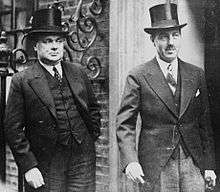
In social policy, a number of progressive reforms were realised during Spaak's first premiership. An Act of June 1938 "increased the functions of the National Society for Cheap Houses and Dwellings and empowered it, under State guarantee, to contract a loan of 350 million francs," while a Royal Decree of July 1938 laid down the rules of applying the provisions of a Holidays with Pay Act passed in 1936 to agricultural, horticultural and forestry undertakings. An Act of 20 August 1938 amended and supplemented the 1936 Holidays with Pay Act by extending its coverage to all undertakings, whatever their number of wage earners, as well as to home workers. The Act also removed a previous requirement in which a wage earner had to work for at least a year with the same employer in order to earn an annual holiday. An Act of 8 July 1938 amended the miners' old-age, invalidity and survivors' insurance scheme by increasing the benefits payable to invalids, aged persons and widows already in receipt of a pension, while also significantly widening the conditions for the grant of invalidity pensions. An Order of 25 August 1938 prohibited the use of so-called motor spirit "for greasing, cleaning (hands) etc.," while a Royal Order of 27 August 1938 fixed normal weekly hours of actual work in the ship-repairing industry in Antwerp at 42 hours "distributed over the seven days of the week." A Royal Order of 27 December 1938 extended the scope of an eight-hour Act passed in June 1921 to cover technical staff employed in cinemas, and a Royal Order of 22 December 1938 amended the entries in the second column of the schedule (list of occupations) which was now brought into conformity with Convention No. 42, and added "in the case of pneumoconiosis, sand-blasting processes in iron and steel foundries.[5]
When he was Minister of Foreign Affairs from 1936 to 1940, Spaak adhered to the political independence of Belgium and carried on the long-standing Belgian policy of neutrality, with no formal military cooperation with France or the United Kingdom and no open hostility to the Germans. On 10 May 1940, Germany invaded Belgium, Luxembourg, the Netherlands and France. In disarray and with almost all of the country occupied, the Belgian Army — by the command of King Leopold III — surrendered on May 18, leading to a constitutional conflict with part of the government (including Spaak), which wanted to continue military operations together with France. The rump of the Belgian government regrouped in Limoges and Bordeaux and stayed close to the French, who surrendered on 22 June. Again conflict rose in the Belgian government between those who wanted to stay in France (and maybe return to Belgium) — among these Spaak and Belgian Prime Minister Hubert Pierlot — and others who wanted to leave for London and to continue the war effort further. Minister Marcel-Henri Jaspar — done with the quarreling — left on June 24 for London and tried to form a new government and obtain recognition from the British. For this, he was thrown out of the government at once by Pierlot and Spaak. After the repeal of diplomatic status by the French, Spaak finally went to Britain. Travelling in difficult circumstances with Pierlot through Spain and Portugal, partially even in the false bottom of a truck, they arrived in London in October 1940.[6]
Post-World War II domestic policies
After the war, he was Minister of Foreign Affairs under the subsequent ministers Achille Van Acker and Camille Huysmans. He was twice appointed Prime Minister as well, first from 13 to 31 March 1946, the shortest government in Belgian history, and again from March 1947 to August 1949. During his last government, two important pieces of housing legislation were enacted. The De Taeye Act of 1948[7] organised fiscal rebates, credit facilities, and premiums for social dwellings built either on private or public initiative, while the Brunfaut Act of 1949 established a central budgeting organisation for governmental social housing policy, shifted the financial burden of infrastructural works to the state, and organised the financing of the two National Housing Societies.[8] A bill on war damage, agreed in October 1947, stipulated that owners of homes damaged by the war and took their initiative to restore them were entitled to compensation.[9] In 1948, voting rights for women were introduced.[10] An Act providing for the establishment of works councils was promulgated in September 1948,[11] while a school building fund was set up that same year "to supply the material needs of secondary education."[12] Also in 1948, the multilateral school was introduced.[13]
Various measures were also introduced to improving working conditions in mines. A decree of September 1947 introduced the compulsory establishment of mine safety services and safety and health committees in all mines, while another Decree issued that same month revised and expanded the provisions related to hygiene installations, medical examination, rescue, and first aid.[14] Automatic indexation of 95% of wages was provided from 1948 onwards,[15] while women were provided with access to the magistracy from 1948 onwards.[16] In December 1948, an Act was passed that replaced the National Society for War Orphans with the National Society for Orphans, Widows and Ascendants of War Victims.[17] Various measures were also introduced to improve working conditions in the mining industry. From June 1947 onwards, all young workers under the age of 18 became entitled to three weeks' annual paid leave, while workers between the ages of 18 and 21 entitled to at least a fortnight. In September 1947, Orders were promulgated providing for the supervision of health and hygiene in mines, surface mines and quarries.[18] In June 1948, legislation was introduced that doubled holiday remuneration for workers,[19] and in August 1948 a law was passed that introduced nonconfessional moral instruction in secondary education.[20]
Foreign policies
He was again foreign minister from April 1954 to June 1958 in the cabinet of Achille Van Acker and from April 1961 to March 1966 in the cabinets of Théo Lefèvre and Pierre Harmel. Although his political base was in the Socialist Party, he disagreed with its policies on several critical points, including Atlanticism, recognition of Franco's Spain, and the language issue inside Belgium.[21] During Spaak's final term as Belgium's Foreign Minister, he presided over Belgium granting independence to Burundi following the assassination of Prince Louis Rwagasore, the country's first elected prime minister. Despite allegations of Belgian involvement in Rwagasore's murder, Spaak appealed to Belgian King Baudouin not to grant Rwagasore's convicted murderer a pardon.[22]
UN
Spaak gained international prominence in 1945, when he was elected chairman of the first session of the General Assembly of the United Nations. During the third session of the UN General Assembly in 1948 in Paris, Spaak apostrophized the delegation of the Soviet Union with the famous words: "peur de vous" (fear of you).[23][24]
Europe
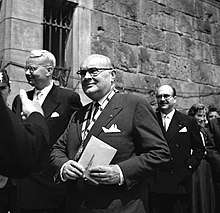
Spaak became a staunch supporter of regional co-operation and collective security after 1944. While still in exile in London, he promoted the creation of a customs union uniting Belgium, the Netherlands and Luxembourg (see Benelux). In 1948 he helped organize a Congress that met in The Hague and set up the Council of Europe. In August 1949, he was elected President of the first session of its assembly where he helped develop a network of intergovernmental contacts in many fields, such as human rights, local government, education, culture, sports, and youth policy. However, the organization only played an advisory role, and was not nearly strong enough to achieve Spaak's goals. From 1952 to 1953, he presided over the Common Assembly of the European Coal and Steel Community, and from 1950 to 1955 he presided over the European Movement.[25]
In 1955, the Messina Conference of European leaders appointed him as chairman of a preparatory committee (Spaak Committee) charged with the preparation of a report on the creation of a common European market. The so-called "Spaak Report[26] " formed the cornerstone of the Intergovernmental Conference on the Common Market and Euratom at Val Duchesse in 1956 and led to the signature, on 25 March 1957, of the Treaties of Rome establishing a European Economic Community and the European Atomic Energy Community (Euratom). Paul-Henri Spaak signed the treaty for Belgium, together with Jean Charles Snoy et d'Oppuers. His role in the creation of the EEC earned Spaak a place among the Founding fathers of the European Union.
NATO
In 1956, he was chosen by the Council of NATO to succeed Lord Ismay as Secretary General. He held this office from 1957 until 1961, when he was succeeded by Dirk Stikker. he feuded constantly with French president Charles de Gaulle. He publicly attacked de Gaulle, blaming him for unjustly and unwisely blocking NATO's progress and stalling efforts toward European and Atlantic integration. De Gaulle was uncompromising in issues related to national sovereignty, mistrusted the United States and considered Britain to be the American puppet; he insisted on developing French nuclear capabilities. Although Spaak used every diplomatic method at his disposal, his opinion mattered little to the main players in NATO.[27] When, in 1962, France, under de Gaulle, attempted to block both British entry to the European Communities and undermine their supranational foundation with the Fouchet Plan, Spaak working with Joseph Luns of the Netherlands rebuffed the idea. He was a staunch defender of the independence of the European Commission. "Europe of tomorrow must be a supranational Europe," he declared. In honour of his work for Europe, the first building of the European Parliament in Brussels was named after him. When France withdrew from an active role in NATO in 1966, he was instrumental in the selection of Brussels as the new headquarters.
On 21 February 1961, Spaak was presented with the Medal of Freedom by US President John Kennedy.[28]
Retirement and death
Paul-Henri Spaak retired from politics in 1966. He was member of the Royal Belgian Academy of French Language and Literature. In 1969, he published his memoirs in two volumes titled Combats inachevés ("The Continuing Battle", literally, "unfinished fights").
Spaak died aged 73, of kidney failure on 31 July 1972,[29] in his home in Braine-l'Alleud near Brussels, and was buried at the Foriest graveyard in Braine-l'Alleud.
Legacy
Paul-Henri Spaak, nicknamed "Mr. Europe", was the main motive for one of the most recent and famous gold commemorative coin: the Belgian 3 pioneers of the European unification commemorative coin, minted in 2002. The obverse side shows a portrait with the names Robert Schuman, Paul-Henri Spaak and Konrad Adenauer, the three unifiers of Europe.
In the election for De Grootste Belg (The Greatest Belgian) Spaak ended on the 40th place in the Flemish version and on the 11th place in the Walloon version.
Distinctions
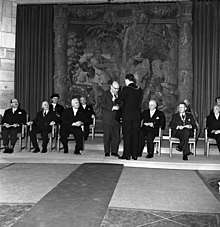
National Honours
.svg.png)
.svg.png)
.svg.png)
.svg.png)
Foreign orders
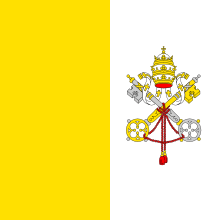














.svg.png)





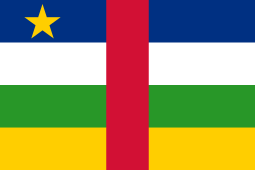
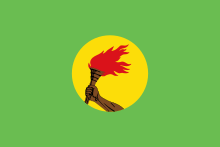







Academic
- Fellow of the American Academy of Arts and Sciences (1950)
Other
- Charlemagne Prize (1957) by the city of Aachen for his merit in the union and security of Europe
- Medal of Freedom in silver with palm by U.S. President John F. Kennedy
- Euro gold and silver commemorative coins (2002)
See also
- Spaak government
- Paul-Henri Spaak Foundation
- Haute École Paul-Henri Spaak
- Paul-Henri Spaak building
- Spaak method of negotiating
- Robert Rothschild, diplomat, chef de cabinet
References
- "Paul-Henri Spaak." Almanac of Famous People, 9th edition. Thomson Gale, 2007.
- "Profile: Paul-Henri Spaak". The Observer. UK. 13 January 1946. p. 6.
- "Catherine Spaak Is Wed". The New York Times. 5 August 1972. p. 13.
- McFadden, Robert (1 August 1972). "Paul-Henri Spaak is Dead at 73; An Architect of European Unity". p. 1.
- The I.L.O. Year-Book: 1938—39
- Stephen George, "Paul-Henri Spaak and a paradox in Belgian foreign policy." Review of International Studies 1.3 (1975): 254–271.
- Melgaard, Ebbe (1 January 2007). Cost C16, Improving the Quality of Existing Urban Building Envelopes: Needs. IOS Press. ISBN 9781586037352.
- Peter Flora, Growth to Limits. The Western European Welfare States Since World War II .
- Nicholas Bullock; Luc Verpoest (2011). Living with History, 1914 – 1964: la Reconstruction en Europe Après la Première Et la Seconde Guerre Mondiale Et Le Rôle de la Conservation Des Monuments Historiques. Leuven University Press. pp. 263–. ISBN 978-90-5867-841-6.
- Jad Adams (2014). Women and the Vote: A World History. Oxford University Press. pp. 290–. ISBN 978-0-19-870684-7.
- Bar-Niv, Zvi H.; Aaron, B.; Elmann, Peter (11 October 1979). International Labour Law Reports. Martinus Nijhoff Publishers. ISBN 9028602798.
- Bulletin of the International Bureau of Education. The Bureau. 1 January 1958.
- Western European Education. International Arts & Sciences Press. 1 January 1972.
- SAFETY IN COAL MINES VOLUME I: Organisation on the National and International Levels, International Labour Office, Geneva, 1953
- Hassel, Anke (1 January 2006). Wage Setting, Social Pacts and the Euro: A New Role for the State. Amsterdam University Press. ISBN 9789053569191.
- Schandevyl, P.E. (2014). Women in Law and Lawmaking in Nineteenth and Twentieth-Century Europe. Ashgate Publishing Limited. p. 27. ISBN 9781472403483. Retrieved 3 February 2017.
- Affairs, United Nations Dept of Social (1 January 1951). Report on Family, Child and Youth Welfare.
- http://staging.ilo.org/public/libdoc/ilo/1948/48B09_43_engl.pdf
- http://staging.ilo.org/public/libdoc/ilo/1949/49B09_90_engl.pdf%5B%5D
- Wolf, Patrick J.; Macedo, Stephen (1 January 2004). Educating Citizens: International Perspectives on Civic Values and School Choice. Brookings Institution Press. ISBN 0815795165.
- Fabien Conord, "Paul-Henri Spaak, héraut ou soliste du socialisme belge?." Canadian Journal of History 49.1 (2014): 1–30, in French.
- afrika focus — Volume 28, Nr. 2, 2015 — pp. 156-164, The murder of Burundi's prime minister, Louis Rwagasore, Guy Poppe, http://www.afrikafocus.eu/file/96
- "3rd sess. [1948]: A/PV.147: Paul-Henry Spaak". United Nations. p. 280.
- "Discours de Paul-Henri Spaak (Washington, 28 septembre 1948)" (PDF). cvce.eu. p. 5.
- Sandro Guerrieri, "From the Hague Congress to the Council of Europe: hopes, achievements and disappointments in the parliamentary way to European integration (1948–51)." Parliaments, Estates and Representation 34#2 (2014): 216–227.
- "Spaak report". Aei.pitt.edu. Retrieved 30 December 2013.
- Pascal Deloge, "Spaak-de Gaulle, 1958–60: charged memories," Revue d'Histoire Diplomatique (2008) 122#2 pp 135–151, in French.
- "President John F. Kennedy Presents the Medal of Freedom to Secretary General of the North Atlantic Treaty Organization (NATO) Paul-Henri Spaak, Oval Office, White House, Washington, DC, 02/21/1961". OPA – Online Public Access. National Archives and Records Administration. Retrieved 4 July 2014.
- McFadden, Robert D. (1 August 1972). "Paul‐Henri Spaak Is Dead at 73; An Architect of European Unity". The New York Times. Retrieved 26 July 2020.
- "SPAAK". ars-moriendi.be. Retrieved 3 February 2017.
- "Le onorificenze della Repubblica Italiana". www.quirinale.it. Retrieved 14 November 2019.
- "Honorary Knights and Dames". www.leighrayment.com. Retrieved 14 November 2019.
- "ENTIDADES ESTRANGEIRAS AGRACIADAS COM ORDENS PORTUGUESAS - Página Oficial das Ordens Honoríficas Portuguesas". www.ordens.presidencia.pt. Retrieved 14 November 2019.
- "ORÐUHAFASKRÁ". Forseti.is. Archived from the original on 26 August 2019. Retrieved 14 November 2019.
Further reading
- Laurent, Pierre-Henri. "Paul-Henri Spaak and the Diplomatic Origins of the Common Market, 1955–1956." Political Science Quarterly 85.3 (1970): 373–396. in JSTOR
- Laurent, Pierre-Henri. "The diplomacy of the Rome Treaty, 1956–57." Journal of Contemporary History 7.3/4 (1972): 209–220. in JSTOR
- Wilsford, David, ed. Political leaders of contemporary Western Europe: a biographical dictionary (Greenwood, 1995) pp. 421–27.
Primary sources
- Spaak, Paul-Henri (1971). The Continuing Battle: Memoirs of a European, 1936–1966. trans. Henry Fox. London: Weidenfeld. ISBN 0-297-99352-6.
- Spaak, Paul-Henri. "Intergovernmental Committee on European Integration. The Brussels Report on the General Common Market" (abridged, English translation of document commonly called the Spaak Report) [June 1956]. (1956). online
- Interview with Paul-Henri Spaak on Meet the Press, (April 5, 1959)
External links
| Wikimedia Commons has media related to Paul-Henri Spaak. |
| Wikiquote has quotations related to: Paul-Henri Spaak |
- Fondation Paul-Henri Spaak
- The Presidency Project – Remarks at the Presentation of the Medal of Freedom to Paul Henri Spaak, Secretary General of NATO – 21 February 1961
- NATO Declassified – Paul-Henri Spaak (biography)
- Newspaper clippings about Paul-Henri Spaak in the 20th Century Press Archives of the ZBW
| Political offices | ||
|---|---|---|
| Preceded by Paul-Emile Janson |
Prime Minister of Belgium 1938–1939 |
Succeeded by Hubert Pierlot |
| Preceded by Achille Van Acker |
Prime Minister of Belgium 1946 |
Succeeded by Achille Van Acker |
| Preceded by Camille Huysmans |
Prime Minister of Belgium 1947–1949 |
Succeeded by Gaston Eyskens |
| Positions in intergovernmental organisations | ||
| New office | President of the Common Assembly of the European Coal and Steel Community 1952–1954 |
Succeeded by Alcide De Gasperi |
| New office | President of the United Nations General Assembly 1946–1947 |
Succeeded by Oswaldo Aranha |
| Preceded by Édouard Herriot Acting |
President of the Parliamentary Assembly of the Council of Europe 1949–1951 |
Succeeded by François de Menthon |
| Preceded by Hastings Ismay |
Secretary General of the North Atlantic Treaty Organization 1957–1961 |
Succeeded by Dirk Stikker |